by Mark Pohlad, Ph.D.
Early in 2018, Mr. Louis Moore Bacon graciously gave to the Abraham Lincoln Presidential Library and Museum a stunning painting of a young Lincoln reading in a forest setting. The picture was in dire shape when he acquired it and required a great deal of conservation, which Mr. Bacon wisely pursued. It has been brought back to vivid life.
Lincoln, clad in buckskin shirt, pants and moccasins, is shown stretched out on the ground against a felled tree in a secluded clearing. The axe with which he has taken down an imposing oak is sunk into its sheared end. The young man’s eyes are cast down at the book he reads, his other hand supporting his head. The ground is peppered with large wood chips, and nearby is a red bandana.
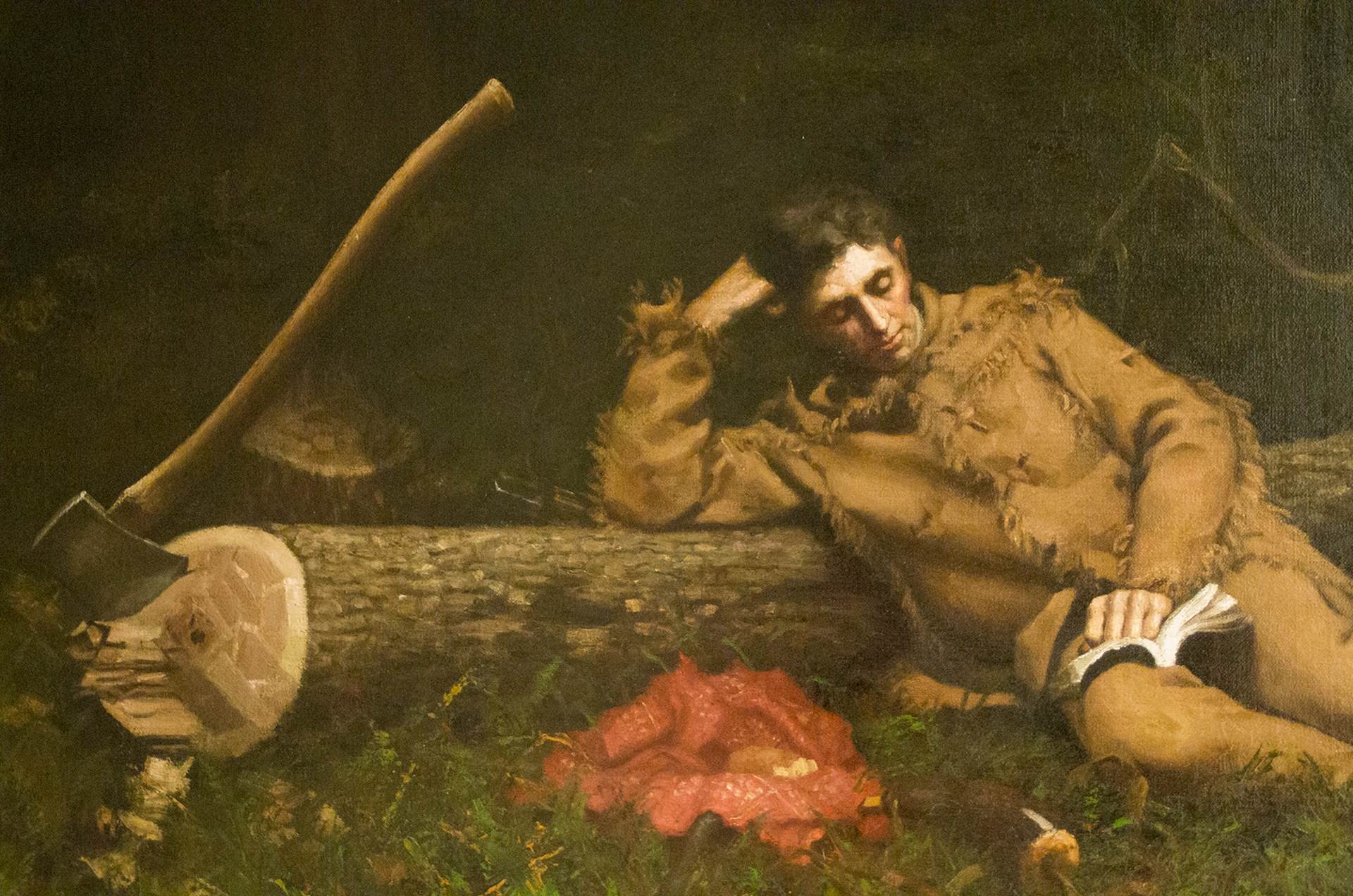 The donated painting
The donated painting
Some years ago, the painting was sold at auction as being by William Morton Jackson Rice (1854-1922), dated c. 1892 and variously entitled The Young Abe Lincoln and Lincoln Reading. It was also presented to the presidential library as the work of Rice, an academically trained, New York-based portraitist who exhibited paintings at various world’s fairs.
However, now that there has been time to investigate, there appears to be no documentary evidence that ties this painting to the hand of Rice. In fact, further research has determined that the picture is by another American portraitist: Morgan J. Rhees (1848-1912).
A print of this painting, dated 1887, is part of the Lincoln Financial Foundation Collection in the Indiana State Museum.
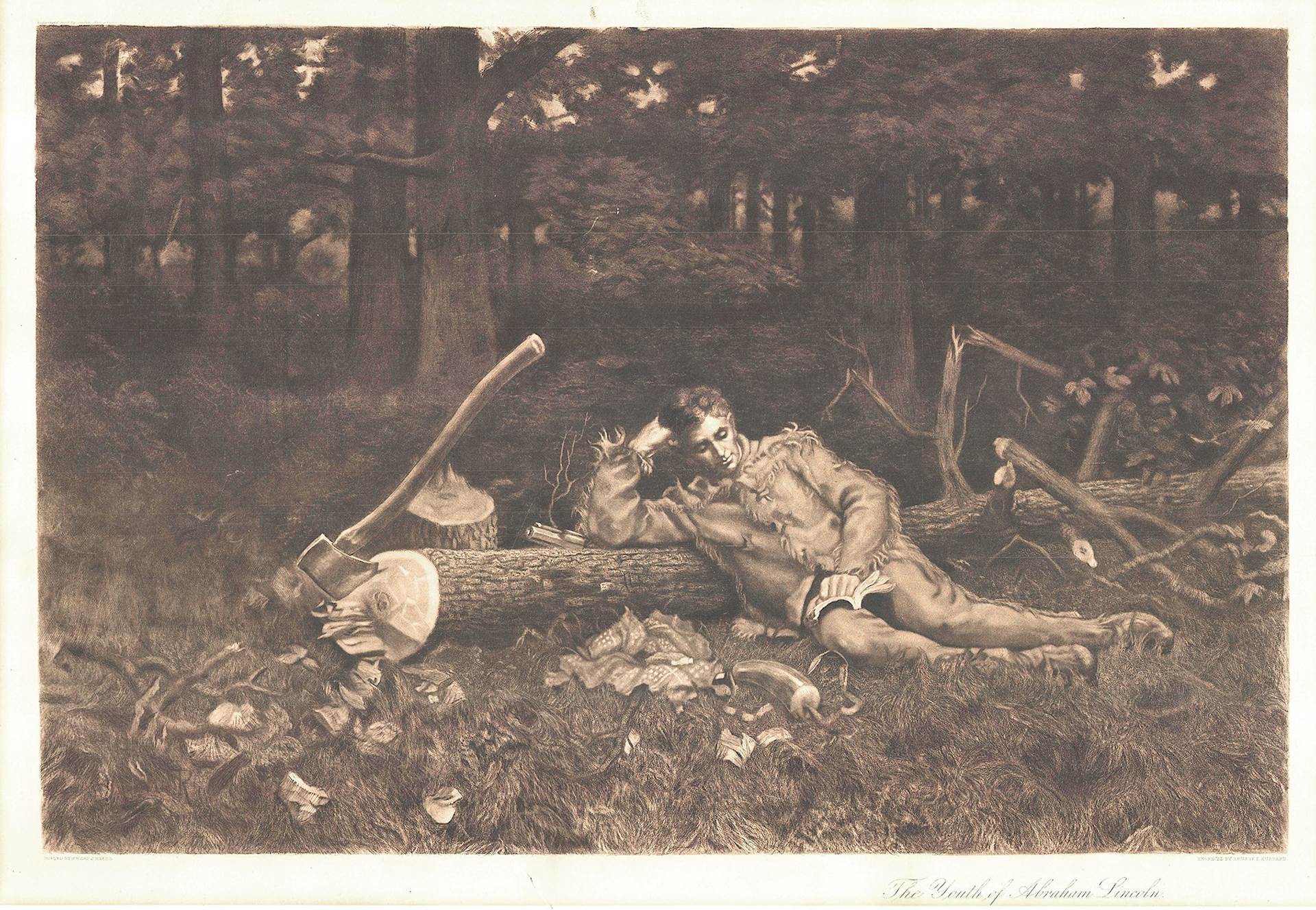 Print by Ernest F. Hubbard, based on painting by Rhees
Print by Ernest F. Hubbard, based on painting by Rhees
The print bears the names of Rhees as the artist and Ernest F. Hubbard as the printmaker. (A modern postcard exists of this print, but it wrongly attributes the picture to the engraver, Hubbard, and omits Rhees’s name altogether). Many nineteenth-century painters entered into deals with publishers to have prints made of their original paintings. In this way, a painter’s one-of-a-kind picture was seen by a much larger audience. The artist, engraver, publisher, and merchants all made money.
In terms of documentary evidence, the painting is mentioned in an 1893 review of an exhibition of the National Academy of Design, then the most important professional body in American art. It positively links Rhees to this artwork, corroborates the title as The Youth of Lincoln, and assigns a date to the painting. Most tellingly, close observation of the painting itself reveals that signature at lower left is signed “Morgan J. Rhees” (not “Morton J. Rice”) in a somewhat crude hand.
Little is known of the life and work of Morgan J. Rhees; his name does not frequently appear in magazines, exhibition catalogues, and books of the period. The Youth of Lincoln is a dramatic departure for Rhees, a portraitist who is known to have advertised his skills in the newspaper and painted images of rich and beautiful women. Paintings by Rhees in public collections include a striking painting of a coast guardsman in the Maine Maritime Museum. Like The Youth of Lincoln, it features a single heroic figure in a wild landscape setting.
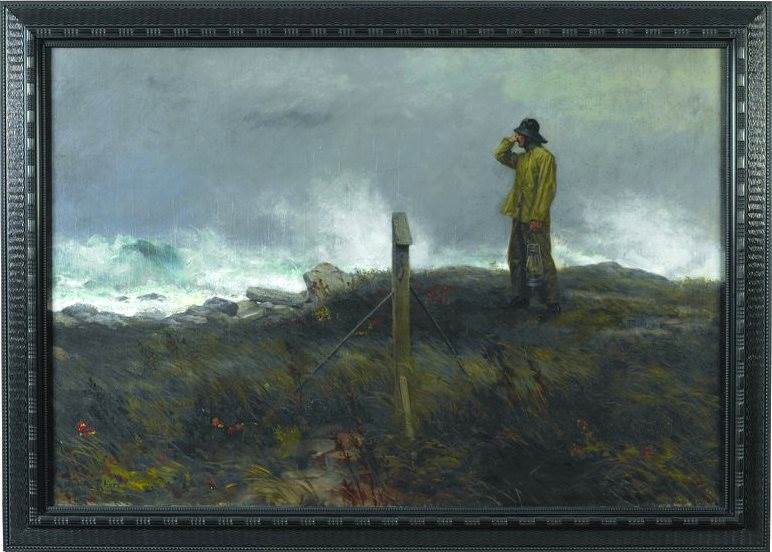 “Coastguardsman Walking His Beat” by Morgan Rhees, (Maine Maritime Museum /courtesy of Portland Press Herald)
“Coastguardsman Walking His Beat” by Morgan Rhees, (Maine Maritime Museum /courtesy of Portland Press Herald)
Rhees’s image of Lincoln is stylistically related to nineteenth-century precedents. The landscape setting’s dense foliage, forest clearing, and varied lights and darks all reflect the influence of the French Barbizon style (1840s-1850s).
The Youth of Lincoln is brimming with symbolism and historical allusions that relate to the Civil War, Lincoln’s career, and even to his assassination. The downed tree calls to mind the soldiers who fell in battle, and those who used such trees for cover in forest skirmishes. A fallen tree, of course, also relates to Lincoln himself, a mighty figure brought down in the prime of his life and career. The tree Lincoln has chopped down may also allude to the political challenges he conquered later, especially slavery. The broken limbs and branches on Lincoln’s left suggest the past – perhaps the war’s destruction – while the cleanly cut tree and axe to his right suggest the future, and perhaps even Reconstruction.
A detail visible in Hubbard’s print, but not so clear in Rhees’s painting itself, is the barrel of a musket propped up on the opposite side of the log. Its muzzle is barely noticeable just to the left of Lincoln’s right arm. The presence of the musket explains the powder horn in the grass in front of him. But these objects raise important questions about the narrative of the painting. Is the weapon meant to suggest that Lincoln has earlier been hunting? Or that he has brought it for his safety? Or both? Symbolically, of course, it references the countless soldiers that would prop their weapons on logs and trees. The barrel of the gun also naturally brings to mind a future gun barrel that would later appear behind Lincoln while he was similarly distracted.
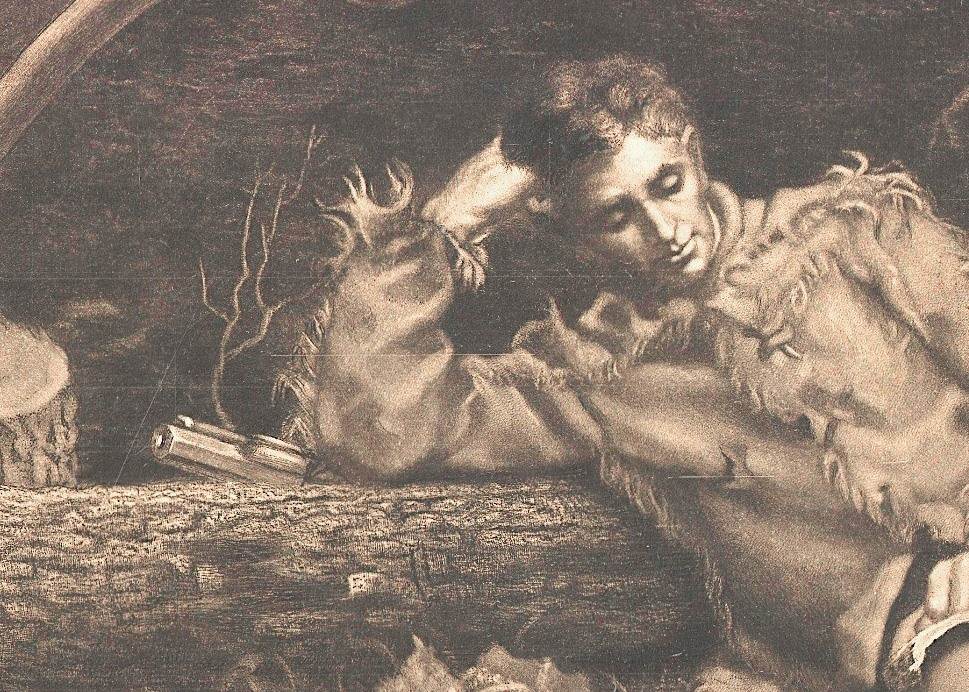 Detail from Hubbard print
Detail from Hubbard print
Images of Lincoln that include guns are uncommon. Ones that show him with his own firearm are practically nonexistent. In any case, its presence here contributes to Lincoln’s identity as a young male pioneer. At the age he is shown, however, he was no longer wearing buckskins — if he ever did (certainly not an entire outfit) — and was already an ambitious young citizen of New Salem.
Consideration of Rhees’s picture brings to mind other examples of Lincoln reading. The most well known are by the American realist Eastman Johnson (1824-1906) who produced three versions of a boy Lincoln reading by the light of the fire.
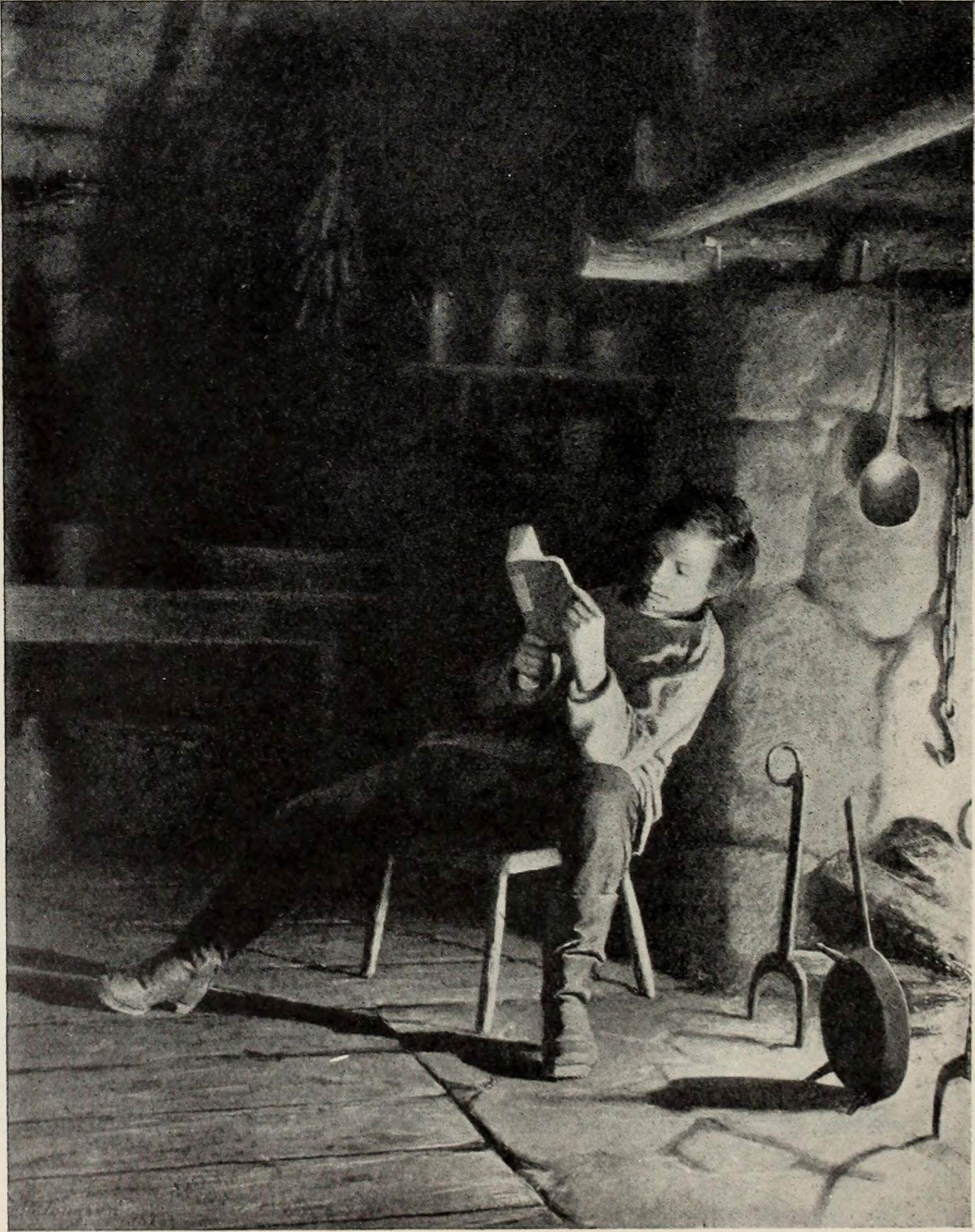 by Eastman Johnson
by Eastman Johnson
But Rhees’s painting is of a young man, not a boy, and he reads outdoors, taking a break from his work. An image of Lincoln doing outside work, made slightly later than Rhees’s, is Lincoln the Railsplitter (1909) by the illustrator Jean Leon Gerome Ferris (1863-1930). Lincoln is depicted wearing a red kerchief like the one on the ground in Rhees’s painting, and an open book appears at lower left.
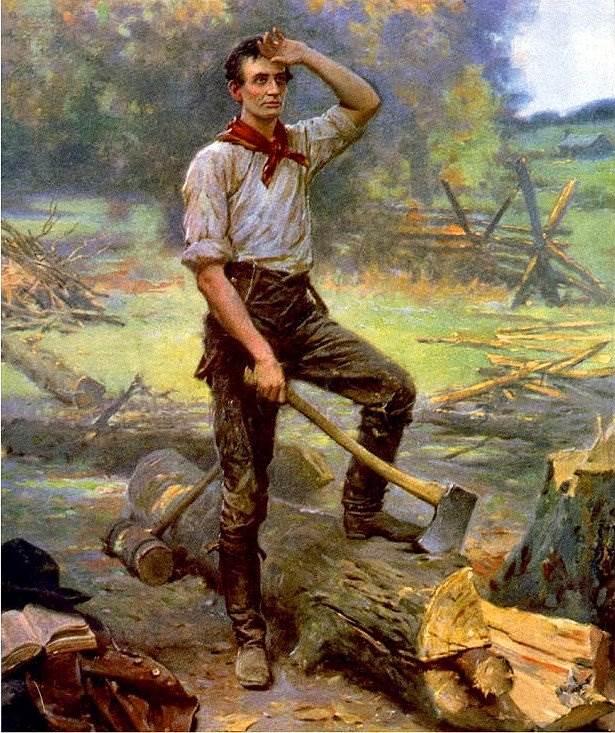 Lincoln the Railsplitter” by Jean Leon Gerome Ferris
Lincoln the Railsplitter” by Jean Leon Gerome Ferris
Norman Rockwell’s well-known painting of a giant, striding Lincoln who carries his axe and reads from a book, is a later example of this Lincoln-the-worker-as reader subgenre.
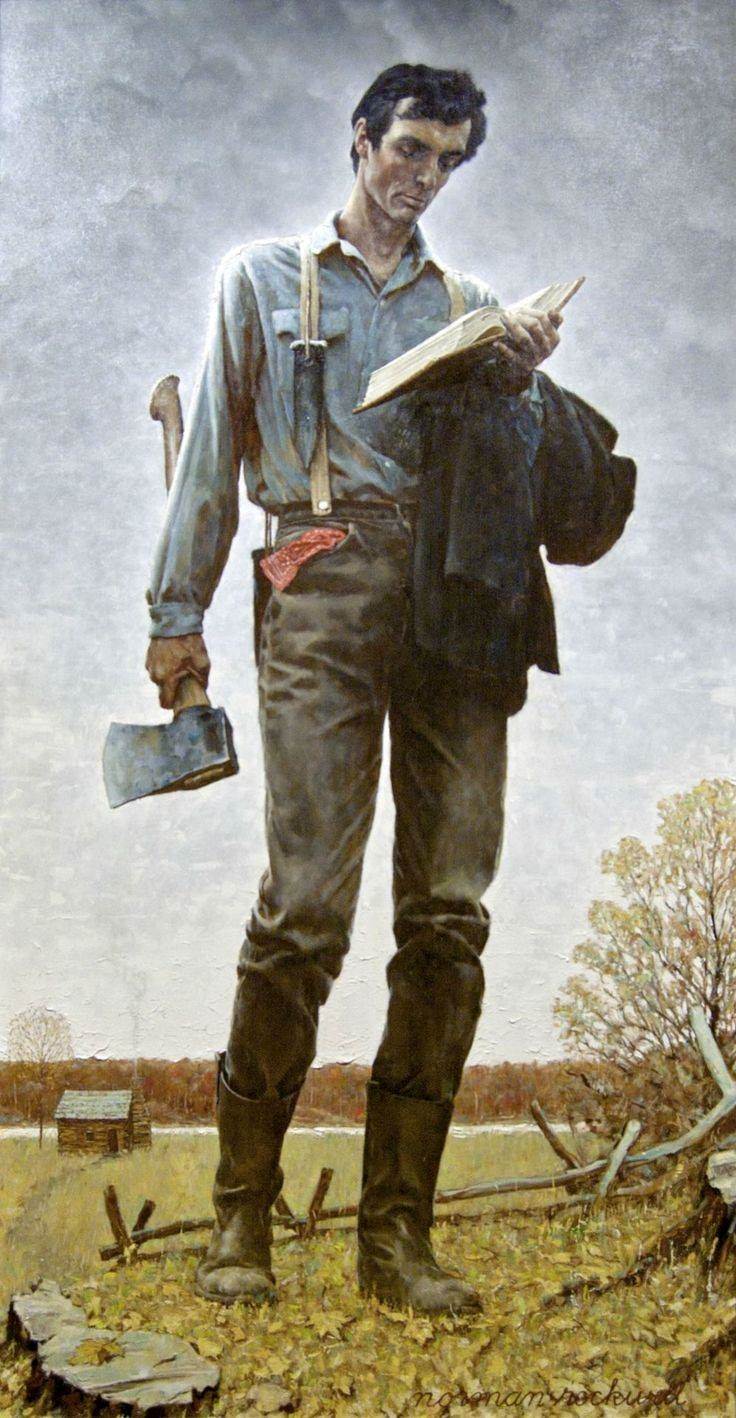 by Norman Rockwell
by Norman Rockwell
It is worth noting that ALPLM has its own image of a youthful Lincoln reading. It’s the three-dimensional figure of the moccasin-wearing boy in the atrium perched on a stump in front of his recreated boyhood cabin. In fact, Rhees’s painting makes a nice pictorial companion to it.
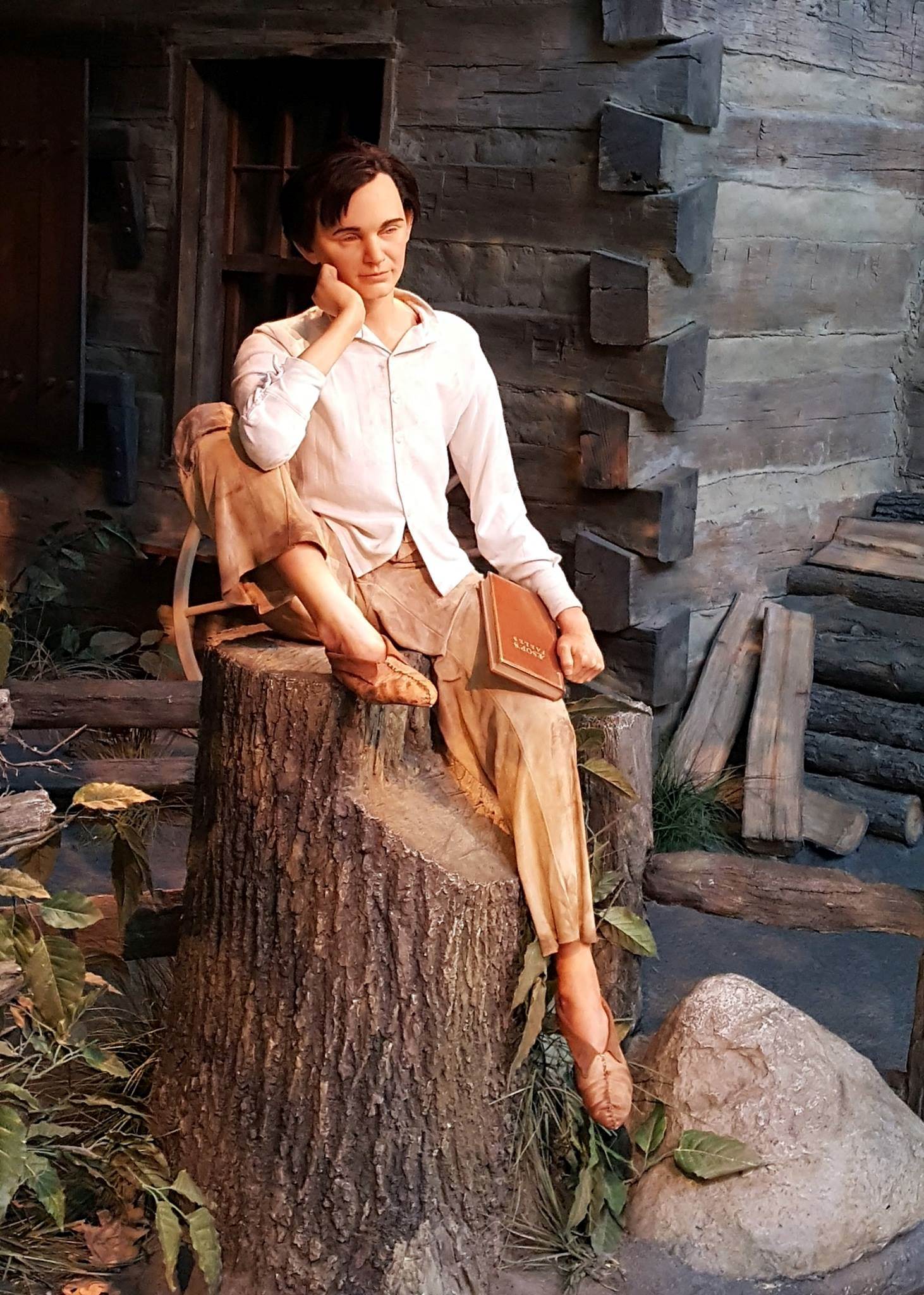 Abraham Lincoln Presidential Library and Museum
Abraham Lincoln Presidential Library and Museum
The Rhees painting has a by-now-familiar narrative. The hands that held the axe a few minutes ago now hold a book. It seems to be a soft-covered volume — perhaps a book of poetry, not a law book — as it bends pliantly across Lincoln’s leg. The kind of physical work Lincoln is known to have resented as a youth has been set aside in favor of learning and self-improvement. On another more general level, this picture might be regarded as a metaphor for civilization itself. The rough pioneer work of clearing and taming the virgin land has given way to time spent on engaging in culture. Such a transformation is also related to the late nineteenth-century Progressive Movement with its emphasis on education, literacy, and self-improvement. The image demonstrates that an ambitious young person could do both manual labor and study or, in broader social-economic terms, that those in the working class could be productive while simultaneously bettering their station with education.
As far as I know, this is the earliest painting of Lincoln reading outdoors. It is also unique in that it shows Lincoln fully reclining. Also notable is the fact that Rhees has not borrowed his portrait from an existing photograph of Lincoln, or on sculptural precedents (such as Leonard Volk’s famous life mask of 1860). Being at heart a portraitist, he may have based it on an actual live model; in any case, he has had to imagine a more youthful Lincoln than any extant photograph. Finally, being a large picture (seven-feet-long by five-feet-tall) it was meant to garner attention as a monumental, academic history painting.
Altogether, Rhees has produced an ambitious, imaginative depiction from the biography of the 16th President. It’s one that reflects his period, when Lincoln was being held up as a model of self-improvement. In my judgment, it is certainly Rhees’s most important and accomplished work and an important addition to the canon of Lincoln-related art. And it has found a receptive and deeply appreciative home at the ALPLM.
Art historian Mark Pohlad has taught at DePaul University since 1992. He received his Ph.D. from the University of Delaware. His research interests include the history of photography and American Art, and more generally the relationships between word and image. He is also interested in local topics, including Chicago art history and the art and photography associated with Abraham Lincoln.